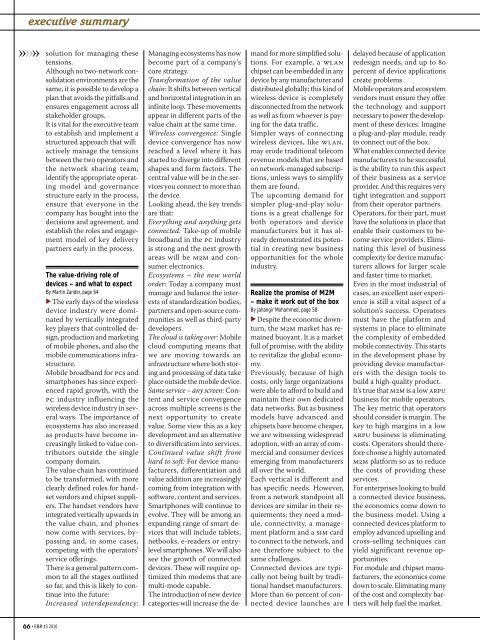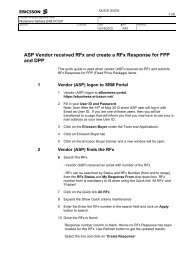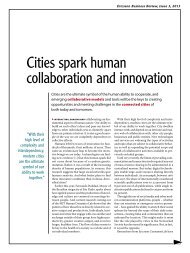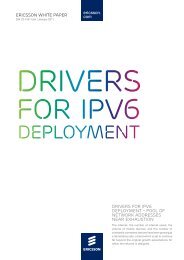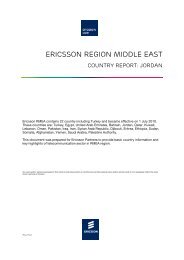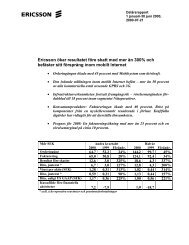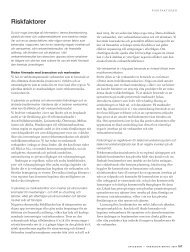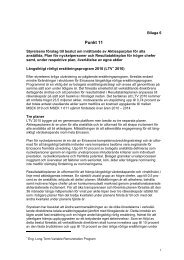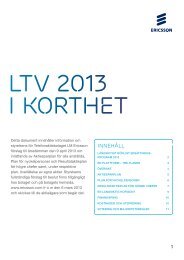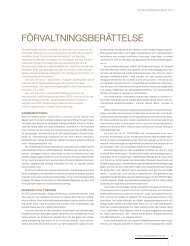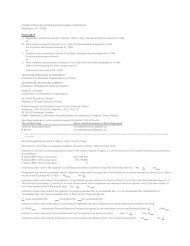Telenor's - Ericsson
Telenor's - Ericsson
Telenor's - Ericsson
- TAGS
- ericsson
- www.ericsson.com
You also want an ePaper? Increase the reach of your titles
YUMPU automatically turns print PDFs into web optimized ePapers that Google loves.
executive summary<br />
»»»<br />
66 EBR #3 2010<br />
solution for managing these<br />
tensions.<br />
Although no two-network consolidation<br />
environments are the<br />
same, it is possible to develop a<br />
plan that avoids the pitfalls and<br />
ensures engagement across all<br />
stakeholder groups.<br />
It is vital for the executive team<br />
to establish and implement a<br />
structured approach that will:<br />
actively manage the tensions<br />
between the two operators and<br />
the network sharing team,<br />
identify the appropriate operating<br />
model and governance<br />
structure early in the process,<br />
ensure that everyone in the<br />
company has bought into the<br />
decisions and agreement, and<br />
establish the roles and engagement<br />
model of key delivery<br />
partners early in the process.<br />
The value-driving role of<br />
devices – and what to expect<br />
By Martin Zander, page 54<br />
▶ The early days of the wireless<br />
device industry were dominated<br />
by vertically integrated<br />
key players that controlled design,<br />
production and marketing<br />
of mobile phones, and also the<br />
mobile communications infrastructure.<br />
Mobile broadband for pcs and<br />
smartphones has since experienced<br />
rapid growth, with the<br />
pc industry influencing the<br />
wireless device industry in several<br />
ways. The importance of<br />
ecosystems has also increased<br />
as products have become increasingly<br />
linked to value contributors<br />
outside the single<br />
company domain.<br />
The value chain has continued<br />
to be transformed, with more<br />
clearly defined roles for handset<br />
vendors and chipset suppliers.<br />
The handset vendors have<br />
integrated vertically upwards in<br />
the value chain, and phones<br />
now come with services, bypassing<br />
and, in some cases,<br />
competing with the operators’<br />
service offerings.<br />
There is a general pattern common<br />
to all the stages outlined<br />
so far, and this is likely to continue<br />
into the future:<br />
Increased interdependency:<br />
Managing ecosystems has now<br />
become part of a company’s<br />
core strategy.<br />
Transformation of the value<br />
chain: It shifts between vertical<br />
and horizontal integration in an<br />
infinite loop. These movements<br />
appear in different parts of the<br />
value chain at the same time.<br />
Wireless convergence: Single<br />
device convergence has now<br />
reached a level where it has<br />
started to diverge into different<br />
shapes and form factors. The<br />
central value will be in the services<br />
you connect to more than<br />
the device.<br />
Looking ahead, the key trends<br />
are that:<br />
Everything and anything gets<br />
connected: Take-up of mobile<br />
broadband in the pc industry<br />
is strong and the next growth<br />
areas will be m2m and consumer<br />
electronics.<br />
Ecosystems – the new world<br />
order: Today a company must<br />
manage and balance the interests<br />
of standardization bodies,<br />
partners and open-source communities<br />
as well as third-party<br />
developers.<br />
The cloud is taking over: Mobile<br />
cloud computing means that<br />
we are moving towards an<br />
infrastructure where both storing<br />
and processing of data take<br />
place outside the mobile device.<br />
Same service – any screen: Content<br />
and service convergence<br />
across multiple screens is the<br />
next opportunity to create<br />
value. Some view this as a key<br />
development and an alternative<br />
to diversification into services.<br />
Continued value shift from<br />
hard to soft: For device manufacturers,<br />
differentiation and<br />
value addition are increasingly<br />
coming from integration with<br />
software, content and services.<br />
Smartphones will continue to<br />
evolve. They will be among an<br />
expanding range of smart devices<br />
that will include tablets,<br />
netbooks, e-readers or entrylevel<br />
smartphones. We will also<br />
see the growth of connected<br />
devices. These will require optimized<br />
thin modems that are<br />
multi-mode capable.<br />
The introduction of new device<br />
categories will increase the de-<br />
mand for more simplified solutions.<br />
For example, a wlan<br />
chipset can be embedded in any<br />
device by any manufacturer and<br />
distributed globally; this kind of<br />
wireless device is completely<br />
disconnected from the network<br />
as well as from whoever is paying<br />
for the data traffic.<br />
Simpler ways of connecting<br />
wireless devices, like wlan,<br />
may erode traditional telecom<br />
revenue models that are based<br />
on network-managed subscriptions,<br />
unless ways to simplify<br />
them are found.<br />
The upcoming demand for<br />
simpler plug-and-play solutions<br />
is a great challenge for<br />
both operators and device<br />
manufacturers but it has already<br />
demonstrated its potential<br />
in creating new business<br />
opportunities for the whole<br />
industry.<br />
Realize the promise of M2M<br />
– make it work out of the box<br />
By Jahangir Mohammed, page 58<br />
▶ Despite the economic downturn,<br />
the m2m market has remained<br />
buoyant. It is a market<br />
full of promise, with the ability<br />
to revitalize the global economy.<br />
Previously, because of high<br />
costs, only large organizations<br />
were able to afford to build and<br />
maintain their own dedicated<br />
data networks. But as business<br />
models have advanced and<br />
chipsets have become cheaper,<br />
we are witnessing widespread<br />
adoption, with an array of commercial<br />
and consumer devices<br />
emerging from manufacturers<br />
all over the world.<br />
Each vertical is different and<br />
has specific needs. However,<br />
from a network standpoint all<br />
devices are similar in their requirements:<br />
they need a module,<br />
connectivity, a management<br />
platform and a sim card<br />
to connect to the network, and<br />
are therefore subject to the<br />
same challenges.<br />
Connected devices are typically<br />
not being built by traditional<br />
handset manufacturers.<br />
More than 60 percent of connected<br />
device launches are<br />
delayed because of application<br />
redesign needs, and up to 80<br />
percent of device applications<br />
create problems.<br />
Mobile operators and eco system<br />
vendors must ensure they offer<br />
the technology and support<br />
necessary to power the development<br />
of these devices. Imagine<br />
a plug-and-play module, ready<br />
to connect out of the box.<br />
What enables connected device<br />
manufacturers to be successful<br />
is the ability to run this aspect<br />
of their business as a service<br />
provider. And this requires very<br />
tight integration and support<br />
from their operator partners.<br />
Operators, for their part, must<br />
have the solutions in place that<br />
enable their customers to become<br />
service providers. Eliminating<br />
this level of business<br />
complexity for device manufacturers<br />
allows for larger scale<br />
and faster time to market.<br />
Even in the most industrial of<br />
cases, an excellent user experience<br />
is still a vital aspect of a<br />
solution’s success. Operators<br />
must have the platform and<br />
systems in place to eliminate<br />
the complexity of embedded<br />
mobile connectivity. This starts<br />
in the development phase by<br />
providing device manufacturers<br />
with the design tools to<br />
build a high-quality product.<br />
It’s true that m2m is a low arpu<br />
business for mobile operators.<br />
The key metric that operators<br />
should consider is margin. The<br />
key to high margins in a low<br />
arpu business is eliminating<br />
costs. Operators should therefore<br />
choose a highly automated<br />
m2m platform so as to reduce<br />
the costs of providing these<br />
services.<br />
For enterprises looking to build<br />
a connected device business,<br />
the economics come down to<br />
the business model. Using a<br />
connected devices platform to<br />
employ advanced upselling and<br />
cross-selling techniques can<br />
yield significant revenue opportunities.<br />
For module and chipset manufacturers,<br />
the economics come<br />
down to scale. Eliminating many<br />
of the cost and complexity barriers<br />
will help fuel the market.


